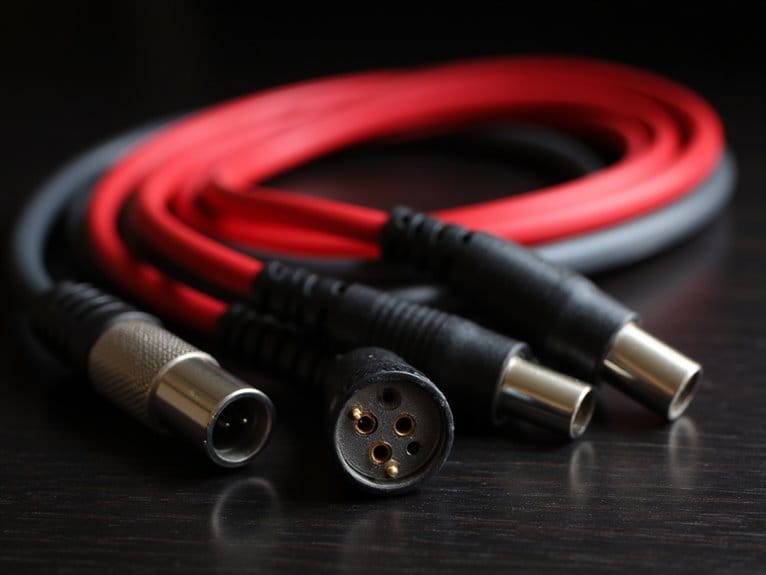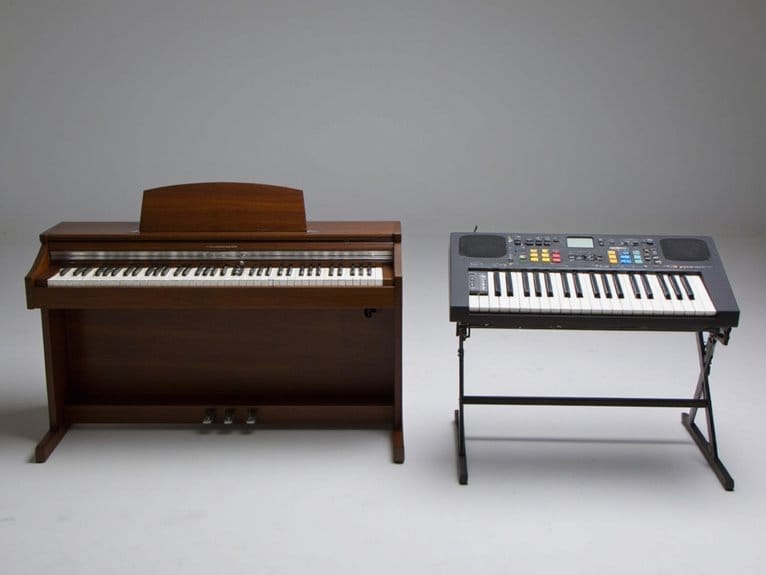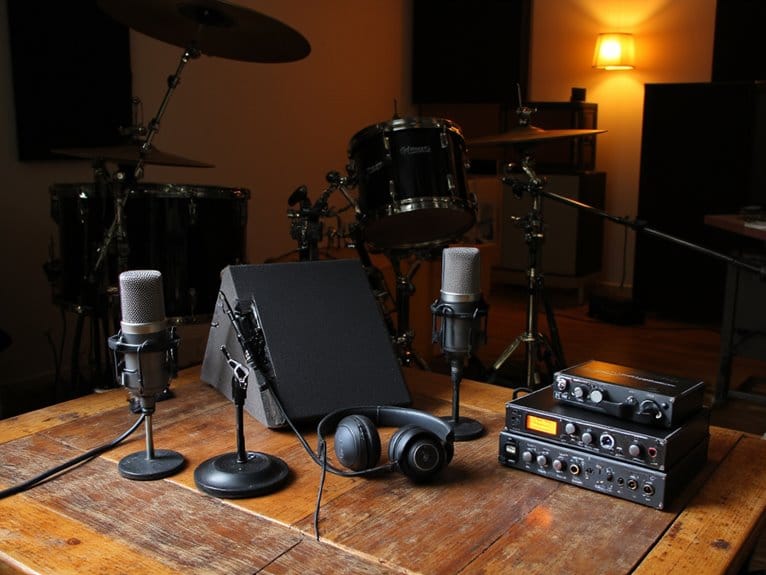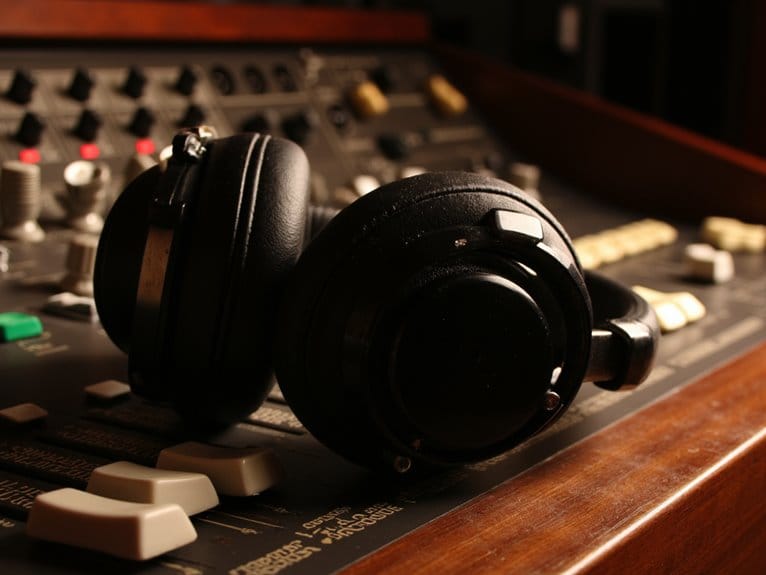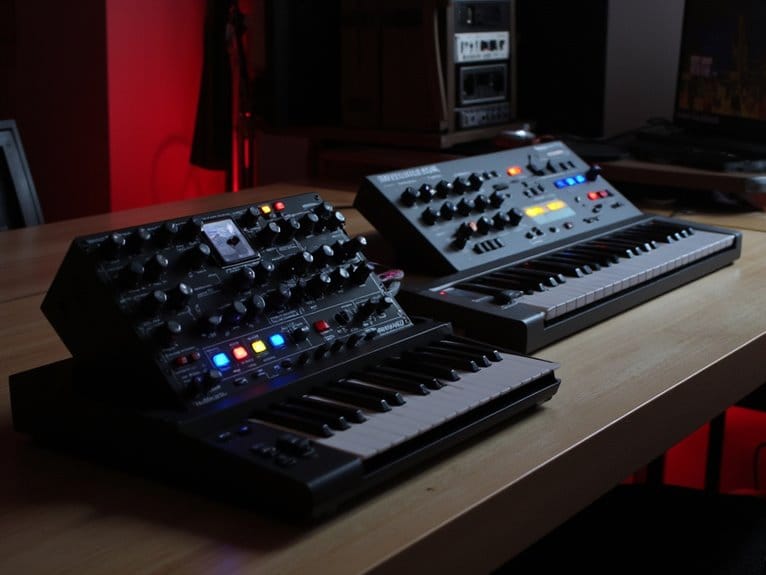Understanding MIDI Cable Types and Connections
You’ll primarily encounter three MIDI connector types: traditional 5-pin DIN connectors with robust metal shells that support runs up to 50 feet, compact TRS connectors using 3.5mm jacks that integrate well with modern interfaces, and USB connections handling both audio and MIDI simultaneously. Type A TRS wiring dominates the industry standard, while Type B creates compatibility issues between manufacturers, and quality cable construction with oxygen-free copper proves vital for reliable signal transmission in professional setups where understanding these nuances becomes essential.
We are supported by our audience. When you purchase through links on our site, we may earn an affiliate commission, at no extra cost for you. Learn more.
Notable Insights
- Traditional 5-pin DIN connectors offer superior durability and signal clarity for distances up to 50 feet with shielded twisted-pair wiring.
- Modern TRS MIDI connectors provide compact design for contemporary setups but may cause confusion due to similarity with audio cables.
- Type A TRS wiring is the MIDI Association standard, while Type B lacks standardization, creating potential compatibility issues between manufacturers.
- Cross-brand compatibility problems arise from differing voltage standards (3.3V vs 5V) and varying MIDI implementation between manufacturers like Roland and Yamaha.
- Optimal MIDI setup requires secure connections, cable runs under 20 feet, shielded construction, and proper strain relief to prevent signal degradation.
Traditional 5-Pin DIN Vs Modern TRS MIDI Connectors
The evolution of MIDI connectivity has brought us two distinct connector philosophies, each with its own strengths and practical considerations that I’ve encountered throughout years of studio work.
Traditional 5-pin DIN connectors offer clear advantages in connector longevity, featuring robust metal shells that provide exceptional physical robustness and mechanical strain relief that’ll outlast most other studio components. Their distinctive circular design prevents accidental misconnection, while shielded twisted-pair wiring guarantees superior signal clarity over lengthy cable runs up to 50 feet. Modern implementations have transitioned to 3.3-volt signaling to align with contemporary electronic design standards and reduce electromagnetic interference. For applications requiring low-profile solutions, specialized compact variants are available that maintain the reliability of traditional DIN connectors while fitting seamlessly into constrained environments.
However, TRS disadvantages become apparent in space-constrained setups where their compact form factor sacrifices some durability, and their resemblance to standard audio cables can create confusion without proper labeling, limiting cable versatility in professional environments. When building a professional studio setup, many producers prefer audio interfaces with MIDI connectivity like the Arturia MiniFuse 1, which seamlessly bridges traditional MIDI hardware with modern USB-C recording workflows.
Type A and Type B TRS MIDI Wiring Standards
Two distinct wiring standards have emerged within the TRS MIDI ecosystem, creating what I’d call a necessary evil in modern MIDI connectivity that you’ll inevitably encounter in your studio setup.
Type A benefits include official MIDI Association endorsement and adoption by manufacturers like Korg, Akai Pro, and Make Noise, where the tip serves as current sink and ring as current source.
Type A’s official MIDI Association backing and widespread manufacturer adoption establishes it as the preferred standard for professional studio connectivity.
Type B drawbacks stem from its reversed wiring configuration, though Arturia and Novation have popularized this approach despite lacking official standardization.
TRS applications span across synthesizers, drum machines, and effects processors, but interoperability challenges arise when connecting different standards without proper adapters. The adoption of 3.5mm minijack connectors has enabled manufacturers to create significantly smaller MIDI devices that maintain compatibility with mobile equipment.
You’ll need specialized cables or 5-pin DIN intermediaries to bridge Type A and Type B devices successfully.
Cable Construction: Materials and Signal Quality
When you’re choosing MIDI cables, the internal construction dramatically affects your signal quality, and I’ve learned through years of testing that copper conductor purity, shielding effectiveness, and connector materials can make or break your setup’s reliability.
You’ll find that high-quality copper conductors with dual-layer shielding—typically foil plus braided wire—provide the cleanest data transmission by eliminating electromagnetic interference that can corrupt your MIDI messages.
The difference between a cheap cable with basic shielding and a well-constructed one with gold-plated connectors becomes obvious when you’re working in electrically noisy environments, where inferior materials often result in dropped notes, timing errors, and frustrating connection dropouts.
Wire Materials Matter
Although many musicians focus primarily on brand names and price points when selecting MIDI cables, I’ve learned through years of studio work that the materials used in cable construction often make a more significant difference in signal quality than most people realize.
When you’re examining conductor options, oxygen-free copper offers especially less electrical resistance than standard copper, which translates directly to cleaner signal transmission and improved cable longevity.
Silver conductors provide even superior conductivity with the lowest impedance, though they’ll cost you more upfront.
The conductor purity and treatment methods also affect corrosion resistance, ensuring your cables maintain consistent performance over time.
Larger wire gauges reduce signal loss, particularly important for longer MIDI runs where every bit of clarity matters.
Shielding Prevents Interference
Since electromagnetic interference can turn even the highest-quality MIDI cables into unreliable signal paths, proper shielding becomes your first line of defense against the invisible chaos that surrounds every modern studio. Understanding shield performance helps you make informed decisions about cable investment, while effective grounding techniques prevent those annoying ground loops that introduce 60 Hz hum.
| Shielding Type | Coverage | Best For | Trade-offs |
|---|---|---|---|
| Braided | 70-95% | General use | Less flexible |
| Spiral | 95-99% | Audio frequencies | Limited digital protection |
| Foil | Nearly 100% | High frequencies | Fragile construction |
| Combination | Maximum | Professional setups | Higher cost |
Smart cable layout, keeping MIDI runs away from power cables and wireless devices, maximizes your shielding materials’ noise reduction capabilities. Even premium cables need proper interference mitigation strategies, balancing cable flexibility with protective performance against common EMI sources.
Device Compatibility and Manufacturer Preferences
When you’re shopping for MIDI cables, you’ll quickly discover that manufacturer preferences create a compatibility minefield, with Roland and BOSS favoring Type A standards while companies like Arturia and Novation typically stick with Type B implementations.
This means your shiny new synth mightn’t talk to your drum machine without the right adapter, even though both devices sport identical-looking 3.5mm TRS ports that seem like they should work together seamlessly.
Fortunately, some forward-thinking manufacturers like Elektron have started incorporating auto-detecting ports that switch between Type A and B automatically, though you’ll still need to verify your specific device’s capabilities before making any cable purchases.
Manufacturer TRS Type Standards
The landscape of TRS connector standards in MIDI devices reflects a fascinating blend of technical necessity and manufacturer preference, where the MIDI Manufacturers Association’s 2018 specification for TRS connectors has created a framework that balances standardization with practical design choices. Despite this unified approach, you’ll still encounter size variations between 2.5mm and 3.5mm TRS connectors, primarily driven by portable device constraints and legacy compatibility requirements.
| Manufacturer | TRS Wiring Standard |
|---|---|
| Korg/Akai | MIDI 4 on Ring, MIDI 5 on Tip |
| Arturia/Novation | MIDI 4 on Tip, MIDI 5 on Ring |
Wiring discrepancies persist across manufacturers, affecting adapter designs and signal integrity. While manufacturer compliance has improved since 2018’s standardization efforts, you’ll need compatible cables and proper understanding of these variations for peak performance.
Device Detection Capabilities
Modern MIDI communication has evolved beyond simple note-on and note-off messages, incorporating sophisticated device detection capabilities that automatically identify connected hardware and negotiate optimal communication protocols between your gear. This advancement allows for a more intuitive setup process, reducing the need for manual configuration. Furthermore, with features like MIDI velocity explained, users can take full advantage of nuanced dynamics, enhancing the expressiveness of their performances. As devices communicate seamlessly, musicians can focus more on creativity rather than technical details.
When you connect devices using MIDI-CI advantages, your equipment performs device negotiation to determine ideal communication pathways, guaranteeing backward compatibility while maximizing performance benefits. This process examines support profiles, conducting channel detection to identify which devices can handle MIDI 2.0’s enhanced message resolution versus traditional MIDI 1.0 data streams.
Manufacturer compliance plays a vital role here, as proper protocol testing guarantees your devices communicate effectively regardless of age differences.
I’ve found this automatic detection particularly valuable when mixing vintage synthesizers with modern controllers, creating seamless integration without manual configuration headaches.
Cross-Brand Compatibility Issues
Unfortunately, even with sophisticated device detection working smoothly, you’ll still encounter frustrating compatibility roadblocks when mixing gear from different manufacturers, since many brands implement their own interpretations of MIDI standards that don’t always play nicely together.
Cross brand discrepancies emerge when Roland pads connect to Yamaha modules, creating altered dynamic response due to impedance differences that manufacturers assume for their ecosystems.
Protocol mismatches become evident when voltage standards clash, as newer 3.3V devices communicate poorly with older 5V interfaces, causing power issues and communication failures.
Some cables omit essential center pin grounding connections, compromising signal integrity when devices expect proper EMI protection.
Firmware revisions across brands introduce timing discrepancies, occasionally requiring intermediate modules to bridge communication gaps between incompatible systems.
MIDI 2.0 Specification Impact on Connector Standards
While MIDI 2.0 represents the most significant evolution in musical instrument digital interface technology since the original 1983 specification, I’ve found that many musicians incorrectly assume it requires entirely new cables and connectors.
The reality is more nuanced, as MIDI 2.0 focuses primarily on protocol enhancement rather than mandating specific physical interfaces.
MIDI 2.0 prioritizes software protocol improvements over hardware requirements, maintaining compatibility with existing connection standards.
You’ll discover that MIDI 2.0 benefits include 32-bit resolution controls, 256 channels across 16 groups, and bidirectional communication capabilities, all achievable through existing USB connections.
However, connector evolution becomes necessary when leveraging advanced features like dynamic capability inquiry and property exchange, which traditional 5-pin DIN connections can’t fully support without bridging hardware, pushing professionals toward faster digital interfaces for peak performance.
Setup Best Practices for Reliable MIDI Communication
Understanding MIDI 2.0’s protocol improvements sets the foundation, but I’ve learned that even the most advanced specifications won’t deliver reliable performance without proper physical setup practices. Additionally, utilizing an Ableton MIDI controller can significantly enhance how musicians interact with MIDI 2.0 features. Ensuring that all devices are correctly configured and connected can help in maximizing the benefits of these advancements. By establishing a reliable physical setup, users can fully leverage the potential of the protocol improvements and achieve a seamless creative workflow.
You’ll want to secure connectors firmly into MIDI ports, because loose connections cause intermittent dropouts that’ll frustrate you during performances. For best signal integrity, I recommend keeping cable runs under 20 feet whenever possible, using shielded twisted-pair construction to minimize electromagnetic interference.
When implementing MIDI troubleshooting techniques, check your cable pin configurations first—Pin 2 handles shield/ground while Pins 4 and 5 carry voltage and data respectively.
For signal loss solutions, avoid tightly coiling excess cable, inspect connectors regularly for wear, and use proper strain relief to prevent mechanical stress during transport or extended use. Modern audio interfaces typically include MIDI connectivity options that complement traditional 5-pin DIN connections, offering greater flexibility for home studio setups. Professional models like the Focusrite Scarlett series provide reliable MIDI I/O alongside high-quality audio conversion for seamless integration of hardware synthesizers and controllers.
Frequently Asked Questions
Can I Use a Regular Headphone Cable for MIDI Connections?
You can’t use regular headphone cables for MIDI connections. MIDI cable types require specific wiring for data transmission, while headphone cables carry audio. MIDI signal differences demand dedicated cables with proper pin assignments.
What’s the Maximum Cable Length for Reliable MIDI Signal Transmission?
You can reliably transmit MIDI signals up to 50 feet with standard cables. Beyond that distance, you’ll experience signal degradation factors like data loss and timing issues affecting MIDI transmission distances.
Do MIDI Cables Carry Audio Signals or Only Control Data?
You’ll find MIDI cables only carry control data, not audio signals. The MIDI signal transmits digital commands like note on/off across 16 MIDI channels, while audio requires separate cables designed for sound transmission.
Can Mixing Type a and Type B Cables Damage My Equipment?
Mixing Type A and Type B MIDI cables won’t damage your equipment due to low-voltage signals and protection circuits. You’ll experience MIDI cable compatibility issues and communication errors, but equipment safety concerns are minimal regarding physical harm.
On a final note
You’ll find that choosing the right MIDI connector isn’t just about compatibility, it’s about understanding your studio’s workflow and future needs. Whether you’re using traditional DIN connections or embracing TRS standards, proper cable construction and wiring knowledge will save you countless troubleshooting hours. As MIDI 2.0 continues evolving the landscape, you’re better equipped to make informed decisions that’ll keep your gear communicating reliably for years ahead.

